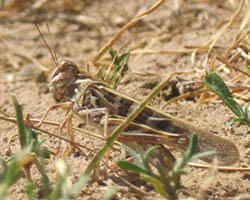
Illustrated by: Gustavo Castaneda
show/hide words to know
The sky darkens with moving sheets pushing across the horizon. What looks like a cloud of dense dust is something entirely different: locusts. Your first thought is to avoid being hit by the flying grasshoppers. But then you realize they are also under your feet.
They are landing everywhere—on the ground, on your crops, and even on your stored food. That's when you realize your biggest problem. The locusts are eating everything.
Around the world, there are many people whose lives depend upon the food they grow on their own land. If locusts eat it all, then people either go hungry or are forced to buy expensive food. Usually a little of both.
Hunger and higher food costs can affect communities in many ways. They may have to spend money meant for school, or healthcare, or other things that a community needs. This is what happened in the West African village in Senegal, where senior sustainability scientist Arianne Cease first encountered locusts.
What Are Locusts?
Locusts are a special kind of grasshopper that can form a swarm. These grasshoppers gather in groups and migrate when exposed to certain conditions, such as a crowded population.
A locust swarm might have almost 100 billion hungry insects in it. A swarm with that many bugs would be almost as big as the entire city of Los Angeles. And an adult locust can eat its weight in food in a single day. Could you eat your weight in food in a single day? No way. Locusts are really, really hungry insects.
And all that hunger can destroy all the plants or crops in an area. All those locusts could eat 423 million pounds of plants in one day. When all the food is gone, the locusts just fly or march along to the next place, leaving a wasteland behind them.
During an outbreak year, locusts could cover one-fifth of all the land on Earth. When that happens, one out of every 10 people on the planet suffers. That’s why Cease studies locusts – to find a way to help the people who have to deal with locust outbreaks.
What Causes a Locust Outbreak?
Locust outbreaks have been happening for thousands of years. Locust swarms are even written about in the Bible. In all that time, people have not found out exactly what causes locusts to swarm and migrate. A crowded population is an important trigger, but there are other environmental factors involved that have yet to be uncovered.
Cease's research team focuses in part on some of the causes of locust migration. Grasshoppers usually like to be alone. So what makes them form hungry swarms and migrate from place to place?
Animals and plants, including insects, need protein to grow. And locust swarms often happen in places where the soil is low in nitrogen – a nutrient necessary to make proteins. In low nitrogen areas, plants can’t make as much protein. Low-protein plants are a favorite snack of locusts.
For some locust species, if they have only high-protein plants to eat, they actually grow more slowly and some even get sick or die. Locusts depend on low-protein food. Low-protein food is often found in areas where cattle or other livestock graze heavily…and even more so, where they graze too much. So overgrazing seems to be one potential cause of locust swarms.
Overgrazing and Outbreaks
When livestock animals eat too much grass from one place over a long time period, it makes the soil less healthy. Nitrogen washes away, and the grasses get low in protein.
When animals graze too much in one area, it can make the soil less healthy. Image by Scott Bauer.
Linking distant communities with such environmental effects is called telecoupling, and it's an important focus for Cease. If locust swarms are going to be lessened in the future, scientists must look at the problem broadly across the landscape and from many different angles.
They must take into account the actions of the farmers, ranchers, and community members, in addition to the biology of the locusts. And they must do this across different countries with separate governments. By getting many of these groups to work together, Cease is hoping to help prevent some of these swarms.
Using an approach like this, Cease and her colleagues just might turn locust management on its head. Working with people from China, Australia, Senegal, Canada, and the United states, they are tackling this worldwide issue so that one day, people won't have to lose so much to locusts.
Learn more about locust research at livingwithlocusts.com(link is external).
Additional images via Wikimedia Commons.
View Citation

Arianne Cease's research takes her across the world, to places like China, Australia, and Senegal. She recently was named one of the BRILLIANT 10(link is external) by Popular Science.
Her collaborators at Arizona State University include Jon Harrison and Jim Elser.
Be Part of
Ask A Biologist
By volunteering, or simply sending us feedback on the site. Scientists, teachers, writers, illustrators, and translators are all important to the program. If you are interested in helping with the website we have a Volunteers page to get the process started.










